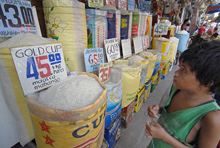
Typical street scene in Santa Ana, El Salvador. (Photo: iStock)
IMF Survey: IMF Revamps Loans for Countries Facing Price Shocks, Disasters
September 19, 2008
- Aims to provide assistance faster, in larger amounts, to low-income countries
- Streamlines policy commitments made by borrower governments
- Intended to help address commodity price changes, disasters, conflicts
The IMF adopted reforms of a loan program designed to help low-income countries cope with emergencies caused by events beyond their control.

Shoppers at rice market: IMF reformed loan program for countries facing shocks from events beyond government control (photo: Jez Aznar/AFP)
LOW-INCOME COUNTRIES
Revision of the Exogenous Shocks Facility (ESF) aims to provide assistance more quickly, and in larger amounts, to help low-income IMF members cope with events such as commodity price changes (including oil), natural disasters, and conflicts and crises in neighboring countries that disrupt trade.
The revamp, approved by the Executive Board September 19, also streamlined the conditionality—commitments that borrower governments make on their economic and financial policies—attached to the ESF. The modifications respond to the request from ministers at the IMF's 2008 Spring Meetings.
Surging food, fuel prices
The ESF was established two years ago to enhance the Fund's ability to help low-income member countries deal with sudden and exogenous shocks. Review of the ESF to make it easier and faster for members to receive the Fund's support has been accelerated in light of experience and the recent worsening of global economic conditions, in particular with the recent episode of surging food and fuel prices that have hit low-income countries particularly hard, an IMF spokesman said.
Key features of the modified ESF include
• Creation of a new rapid-access component under which a country could access fairly quickly, up to 25 percent of its quota for each exogenous shock, with resources normally being provided in a single disbursement. This component could be used on a stand-alone basis or as a first step towards higher access.
• A high-access component, along the lines of the current ESF, with access up to 75 percent of quota for each arrangement in normal circumstances. Resources would be provided in multiple disbursements based on reviews. This component could be used following a rapid-access component, or on a stand-alone basis.
• Conditionality and requirements for access to ESF financing have been streamlined. Under the rapid access component the member would need only to commit to appropriate policies to address the shock, and in exceptional cases, to take targeted upfront measures. Under the high-access component an economic program of upper credit tranche quality would be needed.
• The ability to be used more flexibly in conjunction with other Fund facilities and instruments, for example, with a Policy Support Instrument (PSI).
• Maintaining a focus on the impact of the shock and the related policies on the poor in program design, while dropping the requirement for a Poverty Reduction Strategy.
Comments on this article should be sent to imfsurvey@imf.org


